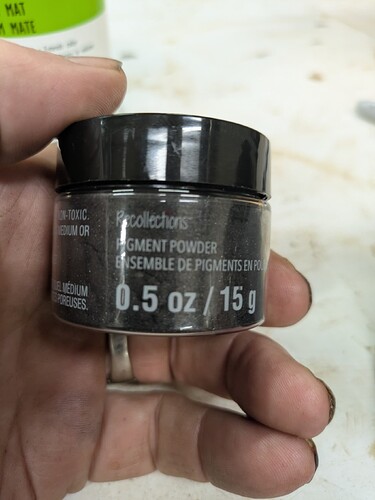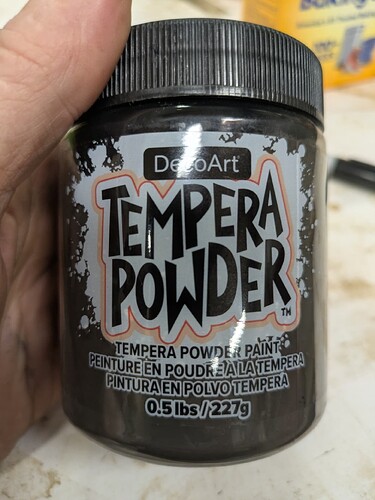I watched a very interesting video on youtube. The video explains using Baking Soda, Mica Powder and super glue instead of epoxy. I have not tried this myself but will be soon. I dont think this would work for every situation but I think it could work for quite a few inlay projects. Watch and see if it is something you might try. If it works it would be considerably cheaper and faster than epoxy.
Interesting. Let us know how it goes.
This would allow multi color projects to happen much quicker.
I’m going to try this. I’ve also used Bondo for a faster setting filler/inlay. Or fast setting (5 minute) epoxy for smaller inlays.
Bondo might sand better since it’s really designed for that. But can you get the colors the way you want them?
I have gray bondo right now, so I’m limited. But you can get it in assorted colors, including white.
Another alternative to the sodium bicarbonate is powdered stone.
The video expressly says to use Mica Powder as your colorant. Some colors like black may take quite a bit of colorant. Any pastel or lighter colors should be good. Have not tried it yet but will be trying it. It will take a good amount of super glue which is not cheap but likely less expensive than table top epoxy. Will post when I try it. I have a lot of liquid colors but the video says expressly not to use liquid colorants because the baking soda will turn to mush. Makes sense to use dry colorants. Several companies offer sample packs of Eye Candy colorants and I will be ordering some. I have used mica power on a river table but with the slow set epoxy you have to stir the epoxy or all the color settles to the bottom. With slow set the epoxy is much like water and even 12 hours later it is still pretty much liquid. With the baking soda and the super glue the drying will be very fast so you can move on with your project. Even with table top epoxy it needs to dry overnight. That slows down a project. Every plus always has some negative. The world is full of compromises. If you dont bend you will break.
Another Cool Trick is Crayons.
I took a bunch of Cayons, broke them into pieces, put them into my pocket, and applied Heat from my Heat Gun.
Got the idea here.
Well, if curing time is the only issue then use of CA glue might be an alternative.
However, CA glue can be roughly $1.75 / ounce while epoxy kits can run less than a $1 / ounce and in larger quantity roughly $0.50 / ounce.
I went to Longview TX yesterday and stopped at Michaels. I bought some Mica Black powder and some Tempora black powder. I had a hard time finding the Mica powder so I found the Tempora powder. After asking for help they showed me the mica powder. I will try both to see if I can get a black color. Since the baking soda is white I might only get gray but will try it.
Will report back if it works.
@CrookedWoodTex The thing about epoxy is it can quite messy. Plus you need a torch to get the air bubbles out. I have tried a heat gun but a torch works better. Having fire in a woodworking shop can be quite dangerous. Plus I have scorched epoxy a couple of times. The thing about the baking soda is it is just another alternative. I have successfully used epoxy but want to try the baking soda to see how it works. The cleanup of epoxy takes quite a bit of acetone to clean out the mixing cups and if you drop it on the bench you have to clean it up. The baking soda and colorant is mixed up and poured into the inlay. Then just adding super glue. There is still a possibility of making a mess but on the surface would seem to be a more contained mess than mixing, addint color and then pouring epoxy. We will see if it works for me but part of woodworking is trying new things. Sometimes they work and sometimes they dont work. Will give it a try and see.
Take a look at this. https://youtu.be/hZJPPt4hK2U?si=jaF0x5vN6PPSEbsq
Is there a particular reason for using Baking Soda other than lightening the color?
The baking soda is really cheap. The video suggested using it. Another one suggests only using mica powder. I bought the baking soda and some mica black powder but have not tried it yet. It is all sitting on my Shapeoko but I have been busy with other projects to try it out. Another video suggests using crushed stones for your color. When I try it out I will post back. The baking soda is quite white so mixing the black may or may not achieve black without a lot of mica powder. Things like red or blue might have the same problem if you want a deep color.
Growing up, we frequently used super glue with baking soda. My brother and I got pretty good at repairing all the knick knack stuff we broke around the house. The baking soda causes the glue to cure almost instantly and it works as a filler.
I think for small inlays it would work well, but I don’t think you’d get the clean, translucent look that epoxy gives with a larger area.
Did your mother ever notice the crack in that vase?
My dad built RC planes and often used some micro bead material long with the CA glue. If he had known baking soda was a viable alternative he would have saved the bucks for sure.
so what are the proportions of baking soda and the mica?
That is the 64,000 dollar question. I bought some baking soda, mica power and have plenty of super glue and will get that soon. So 50% white (baking soda) and 50% black will likely make gray. So likely it will take quite a bit of black mica powder to get close to black. I think that other colors that you dont want a real intensity will work. I posted further up a video where only mica powder is used and no baking soda. Others have commented that the epoxy is not all that expensive but you have to have it on hand and mixing and disposing of the excess is quite messy. I just want to try it and see if it works to I have another arrow in my quiver to use. There are some cases where it may not be the best but the same can be said for epoxy. Some projects the baking soda may work well and some not. I wont know until I try it and see. But I will try to get a dark black and will report back my mixing percentages. Pretty sure for black it will a lot more black mica than baking soda.
Why not just use black CA glue?
I think you need filler to save some money. Plus any amount of thickness would take a while to dry or may never dry unless you do it in very thin layers. Or did you mean black CA in place of the mica powder?
I mean, use Black CA glue to darken it up.
Use Baking Soda, Mica Powder, and black CA glue. That should make it plenty dark.



